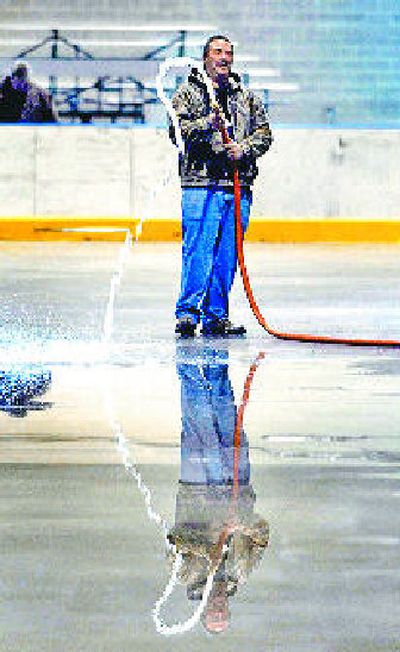No rinky-dink ice

Right away, something seems different about figure-skating ice.
That perception is correct, says Dave Gebhardt, operations director for the Spokane Public Facilities District. Compared with the ice his crew lays down for Spokane Chiefs hockey games, the figure skaters’ stage is thicker, warmer and has a blue hue.
Hockey ice is 1 inch thick, while the figure skaters’ type of pounding mandates more depth.
“Figure skaters, of course, instead of just skating forward and backward, get aerial and come down with their toe picks,” said Gebhardt. “If you kept it at 1 inch, they’d be hitting their toe picks on concrete. So, you’ve got to prepare, at a minimum, an inch and a half – but they prefer 2.”
Constructing perfect layers of ice has been Gebhardt’s passion for 35 years. The Priest River resident is now considered a national expert on creating a sheet of ice that can please the most finicky of skaters.
All of the senior championship events for the U.S. Figure Skating Championships will be held on the Spokane Arena’s regulation 200-foot-by-85-foot surface. Gebhardt and his crew are overseeing that all-important job under the supervision of Bruce McNally, of the sanctioning United States Figure Skating Association.
McNally, 66, of Sarasota, Fla., is a volunteer technical expert for U.S. Figure Skating. He has been to 15 U.S. Nationals over the last 20 years after being trained by the skating association at a weeklong school.
McNally arrived in Spokane late Tuesday and is supervising the ice going in at the Convention Center’s temporary rink. Once the competition begins, he will be the liaison between the skaters and the facilities if issues arise with the ice.
But neither McNally nor Gebhardt is worried about how Spokane’s ice will measure up. The city has a long history of successful surfaces – dating back to the early days of Champions on Ice in the 1990s and Skate America in 2002 – thanks in large part to Gebhardt and the Public Facilities District’s reputation.
“I was here as an ice tech when we did Skate America,” said McNally. “I also came here two years ago when we did the site selection. … Dave and his crew are very much into participation, getting involved, and aren’t real casual. They’re real good and they want it to happen and happen right for the skaters.”
In preparation for this event, Gebhardt’s employer sent him to the past two U.S. Figure Skating Championships, in Portland and St. Louis, to see how things are done. At each stop, he learned a few more tricks of a trade that’s both art and science.
The art comes in the knowledge of a particular rink (from its cooling equipment quirks to ventilation circulation patterns), variables that are hard to calculate while making ice over several days. But the end product is verified through quantifiable methods.
“They sit here with humidity guns, wanting to know the exact humidity of a building, and they do infrared readings on the surface temperature of the ice,” said Gebhardt.
Figure skaters prefer ice at exactly 24 degrees. In contrast, hockey ice is between 16-18 degrees at the Arena.
“It takes a lot of attention to what you’re doing in the refrigeration room,” says Gebhardt. “If it gets too soft, the ice won’t freeze; if it’s too cold, it gets brittle on them.”
When Gebhardt talks about making great ice, his eyes light up; it’s a passion for this 50-year-old, whose workdays often extend to 24 hours during events of this magnitude.
“I’m here for the love of what I do,” Gebhardt said.
And the color? It’s called “TV Blue” and both U.S. Figure Skating and the National Hockey League – but not the Western Hockey League – require it. Apparently ice looks better on television in that color than in its natural state.
That’s just one fact that can be learned by hanging out with Gebhardt and McNally, who are both part of a small clique of obsessive ice creators who hope their work goes completely unnoticed during the eight days of skating in Spokane.
“That’s the ultimate compliment,” says Gebhardt. “When you don’t hear complaints, it’s a beautiful world.”